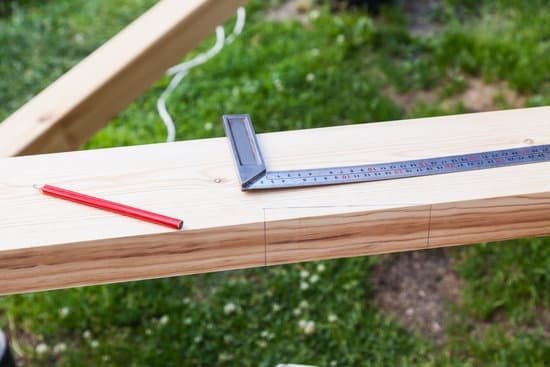Introduction to Template Woodworking
Template woodworking is a technique used to improve the accuracy and efficiency of woodworking tasks. It involves using a template, which can be made from a variety of materials including metal or plastic, to trace patterns onto pieces of wood and then cutting along those patterns. This technique provides much better precision than other methods, as it eliminates human error and allows for more consistent cuts. By following the exact path of the design, skilled craftsmen can quickly create uniform parts from wooden boards.
The main benefits of template woodworking are speed, accuracy, and cost savings. With template woodworking, you can work faster because you do not have to draw out your design on the material before you begin cutting – the template does this job for you. Additionally, using templates helps reduce errors by ensuring that components match up perfectly with one another and that pieces are cut in their proper locations without needing to be adjusted during assembly. Additionally, there are also cost benefits gained by being able to produce identical components much faster than would be possible with manual methods.
One potential disadvantage of using templating is that it requires additional set-up time in order to create each new template as designs change or when creating large numbers of parts which require multiple templates. However, this cost must be weighed against the time saved by not having to manually draw out patterns each time a piece needs carved or cut. Additionally, some experienced craftsmen may find that the use of sophisticated templates takes away from their creativity when designing custom furniture pieces or intricate curves in woodwork-heavy projects because it limits their ability to freehand sketch an idea on a board before committing it to shape with tools.
Template woodworking is best used for applications where precise parts are required but significant emphasis is placed on time savings. Examples include high-volume production jobs like cabinet making or repetitive tasks like similar furniture frameworks since templates permit exact duplication of measurements between different projects reducing both material costs and man hours in certain situations.
Popular Template Woodworking Tools
Template woodworking tools are used for creating specialized cuts, shapes, or forms with accuracy and consistency. A few of the most popular template woodworking tools include: biscuit joiners, router templates, circle jigs, template guides, and mortise jigs.
Biscuit joiners help keep all your wood pieces aligned at the same height during assembly. Unlike a dowel or pocket hole joint where you’ll have to predrill, a biscuit joiner makes a plate joint by cutting shallow patterns in both pieces that fit together like a puzzle piece.
Router templates help make uniform cuts with intricate shapes with precision and accuracy than can’t be achieved with manual saws. These templates come in different materials like foam board or plastic depending on what type of cut you’re making. This tool is perfect for cutting door panels or complex profiles on panel edges.
Circle jigs help make intricate circular joints between two pieces of wood in order to strengthen them and make them look more appealing. It’s important to note that these jigs work best when they are perfectly aligned so it’s important to purchase one that has adjustable arms in case you need to make more accurate measurements.
Template guides allow you to create consistent grooves and dadoes on the edge of your workpiece without damage from the router bit head itself. They come available in many sizes so it’s important to pick one that matches your project specifications.
Mortise jigs allow seasoned and amateur woodworkers alike to easily create mortises for use with dovetails or other fancy joints without having to measure each mortise-cut out individually which can take much longer andcause mistakes if not done correctly using manual tools.. It is an essential tool for ornamental work such as cabinetry or fine furniture making as well as general construction projects such as window frames and doors wherein precise mortise-tenon joints are required
Types of Template Woodworking
Template woodworking is a form of carpentry where the main focus is the production of consistent, uniform shapes in wood. Template woodworking usually involves crafting complex shapes by first cutting a template or pattern out of wood, then repeating the process across multiple boards. Common uses for template woodworking include making furniture or decorative items such as ornamental moldings and carved figures.
Types of materials used with template woodworking vary depending on the desired result. Masonite or oak plywood are popular choices for templates due to how sturdy they remain when cut into desired patterns and designs. For smaller projects, some prefer to use hardwood species like cherry or walnut due to their more intricate grain patterns and ability to hold more detailed carvings.
In addition to choosing specific materials, different techniques can be employed when using templates for carpentry projects. Carving is perhaps the oldest method practiced in this field and includes powerfully shaping objects with chisels, gouges, and rifflers. Hand sawing also requires powerful strokes but utilizes a more precise cut than carving does – these are commonly seen with crosscuts made in thinner boards such as laminates or veneers. Constructive processes such as mitering also involve creating customized sections that fit together perfectly per the intended design. Finally, 3D printing can be used to quickly create templates with high levels of accuracy if computer modelling programs are employed during the construction phase of projects.
Steps to Excel with Template Woodworking
1. Research: Research all available resources to gain a comprehensive understanding of template woodworking techniques and tools. Search online and read books, watch videos, or take an introductory course in the craft if you are unsure of what to do. In addition to gaining knowledge, examining examples can help inspire ideas and get the creative juices flowing.
2. Plan: After researching template woodworking, carefully plan out a project before getting started so that you know exactly what to expect and how the results will look in the end. Make sure to invest enough time in planning as it is essential for success.
3. Gather Necessary Supplies: Once a plan is formulated, start gathering all of the necessary supplies for your project. This could include power tools like jig saws, routers, sanders, clamps, templates and measuring devices such as rulers and angles calculators. Also make sure to have plenty of the raw materials you’ll need – from wood screws to plywood sheets – accessible so that all parts fit together perfectly in the end.
4. Get Creative: Template woodworking affords limited control over freehand work but can still be fun if creativity is emphasized with design challenges such as carving complex shapes or experimenting with different colors or textures using paints or stains.
5. Put it Together: Put all of your elements together per your planned outline while double-checking dimensions throughout the process until each part fits perfectly into place following established measurements and specific instructions set forth by the templates and routing guides used in the project itself.
6. Finishing Touches: Once all pieces are put together give them one last look over & finish off with sandpaper for any rough edges then add a coat of paint or polyurethane if desired once everything has been properly dried and hardened according to product instructions for best results
Common Mistakes to Avoid in Template Woodworking
There are several common mistakes that beginners in template woodworking should look out for, such as:
1. Failing to measure accurately before cutting – Make sure to double-check that your template, pattern and dimensions are all accurate. This includes both measuring the width and height of the material, as well as double-checking to ensure angles are correct too. Before beginning a project, also make sure you have all the tools you require to complete it as needed.
2. Inaccurate cutting – Bad cuts can ruin a project quickly if not done correctly. Take your time, use slow steady strokes and make sure the blade is free from obstructions like sawdust or rust before each cut.
3. Poor sanding technique – Poor sanding can decrease the quality of your finished product and leave embedded particles or streaks behind in the wood that won’t go away no matter how much buffing you do afterwards. Use a medium grade sandpaper suitable for the type of wood used, and always finish off with finer grades after rough sanding has been completed to get a smooth finish result.
4. Incorrect fastening techniques – Avoid using nails when constructing bigger projects as they will not be reliable enough compared to screws, glue or clamps. Also practice good safety by using gloves, masks and specialized clothing when working with fasteners such as screws or staples so that no accidents happen while installing them into the material you are working with.
5. Not respecting grain direction – If you fail to align the grain pattern of your pieces correctly then it will be evident visually in the finished product, immediately diminishing its overall appeal. Respecting grain patterns is an important part of any template woodworking project for this reason ” plan each cut carefully prior to making it!
Finishing Touches in Template Woodworking
Template woodworking is a great way to create beautiful and unique items. While skill is of the utmost importance, you can add a professional touch to your projects by taking time to add finishing touches. Here are some tips on getting the perfect finish on your template woodwork:
1. Before adding any finish to your item, make sure that it is properly sanded and free of any blemishes or dents. Taking extra care in this step will ensure a smooth surface when applying paint, stain or other finishes.
2. To get that glossy look for stained pieces, choose an oil-based varnish rather than a water-based one. This will protect your item from scratches and give it shine without being tacky or sticky to the touch.
3. If you choose to use paint for your template woodwork, make sure to apply primer first and let it dry completely before applying the top coat. You may want to consider using light sanding between coats in order to give the piece an even finish.
4. Make sure you use only tools meant specifically for woodworking such as hammers, chisels and planes when performing detailed work on the piece. Not only will these tools allow more precision but they’re also much safer than regular tools which could damage nails and other parts of the finished piece if not used correctly.
5. Pre-treating your item with shellac before painting or staining can help avoid bleeding of colorant into lighter areas of the project such as knotholes or joints.”
Inspiring Template Woodworking Stories
Template Woodworking is a term used to describe the art of creating furniture, sculptures, and other projects out of wood with the use of precision templates. It allows for quick production and repeatability that can create any desired design in a matter of minutes. While this method may produce stunning results with ease, there are also some stories of amazing creations that have gone above and beyond.
One example is the breathtaking birdhouse designed by Scott Slinkard. Drawing on his experience as an engineer in the US Air Force, Slinkard used templates to create an unbelievably detailed miniature-scale replica of an actual 16th Century historic English home. Every tiny detail was exact; from windows to shingles, appropriate hardware and even clay tiles on its roof.
Another breathtaking project was created by Colorado-based artisan Jonathan Chambers. He decided to test his mettle by crafting a large wooden tribute piece dedicated to legendary skateboarder Tony Hawk in record time using template woodworking techniques. Despite having just two weeks for the entire project, Chambers brought his handcrafted artistic vision to life: a replica figure of Tony Hawk performing one of his renowned airborne maneuvers!
These inspiring stories prove that template woodworking has potential far beyond traditional expectations ” it can bring unique ideas and masterpieces into existence that nobody could have imagined before!
Conclusion
Template woodworking is a great choice for woodworking projects because it can be done quickly and with great precision. With templates, you don’t have to spend time measuring and marking pieces of your project. You just need to line up the template on your material, drill or cut as requested, and move on to the next piece. This saves both time and energy that can then be used elsewhere in your project. In addition, template woodworking allows you to cut parts that are exactly the same size and shape for a clean finished product. This level of accuracy is highly desirable in many projects ranging from furniture-making to toy-making and more. Most importantly, there is no guesswork involved as every part you cut will fit perfectly into the one before it due to the durability of well-made templates. Taking all of these reasons into consideration, template woodworking provides a great solution when making quality projects in any area of woodworking.

Hi everyone! I’m a woodworker and blogger, and this is my woodworking blog. In my blog, I share tips and tricks for woodworkers of all skill levels, as well as project ideas that you can try yourself.





